Project Name
The making of Seven Seas collectionPosted in
Jewelry DesignJewelry Designer
Van Cleef & ArpelsYear
2015Venue
VCA AteliersVisit Website
vancleefarpels.com| Detailed Information | |||||
|---|---|---|---|---|---|
| Project Name | The making of Seven Seas collection | Posted in | Jewelry Design | Jewelry Designer | Van Cleef & Arpels |
| Year | 2015 | Venue | VCA Ateliers | Visit Website | vancleefarpels.com |
True virtuosos of their craft, the jewellers, polishers, designers and gem setters of Van Cleef & Arpels are dedicated and truly passionate about what they do — in fact, some of them see their work as more like a hobby or a way of life that combines artisanal skill with pleasure. More than a few of Van Cleef & Arpels' ‘golden hands’ have been working for the maison for decades, often hailing from families that are also in the jewel-making trade. Thus, Van Cleef & Arpels fosters an extended family of some of the best jewel designers and makers in the world, and ensures that their skills are honed and challenged by a constant search for innovation and the highest standards of quality. Apart from jewellers, stone sorters, gem setters and the like, the jewellery house also employs moke-up makers, engravers, sculptors, painters and many other artists who help create the elaborate, one-off artefacts seen in Van Cleef & Arpels' collections. When I visited the Ateliers, the new summer collection named ‘Seven Seas’ was being created. What struck me the most was the fine scale of the work: it is simply amazing how so much detail and elaboration can fit into the smallest surfaces of a watch, a ring or a brooch!
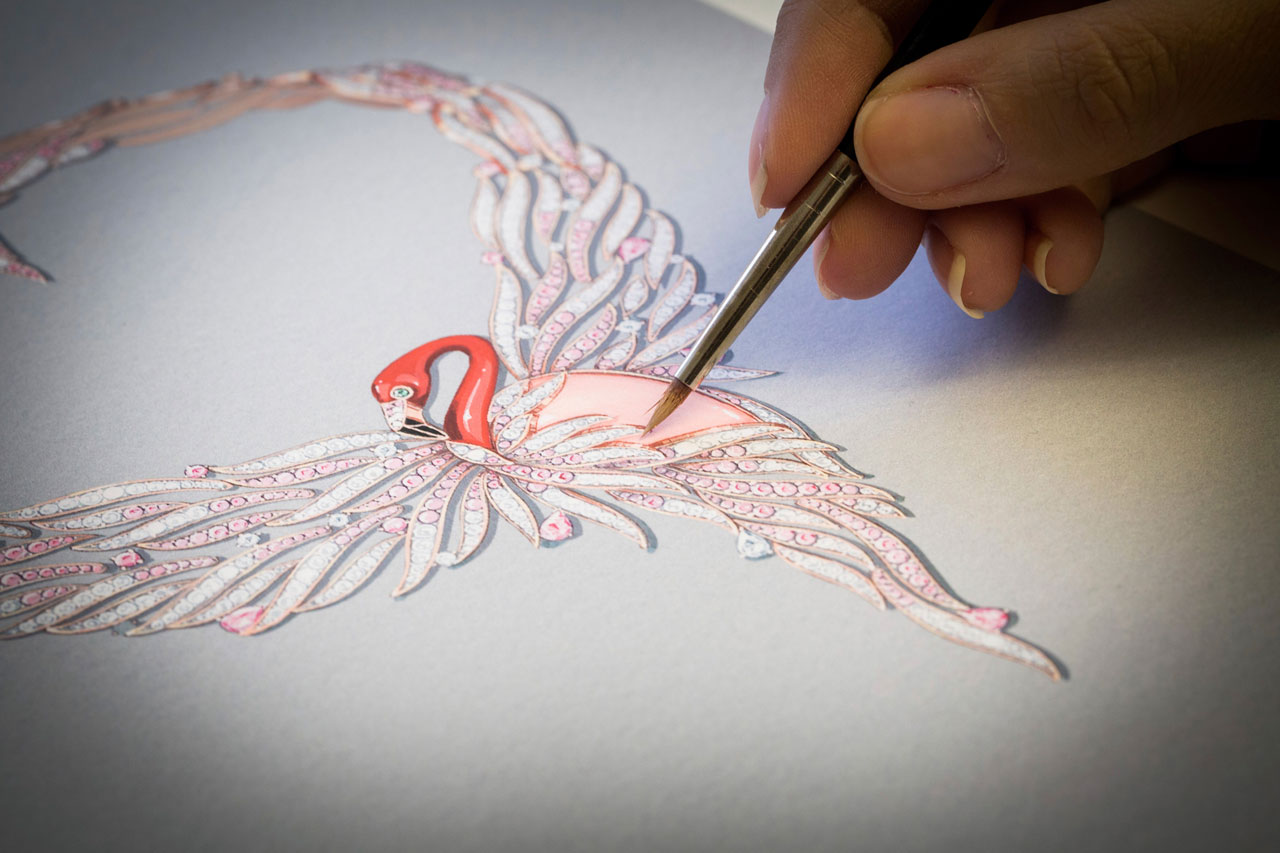
Flamant Corail necklace sketch. Photo © Van Cleef & Arpels.
The Making Process

Positioning the jewelry structure of the Flamant Corail necklace. Photo © Van Cleef & Arpels.
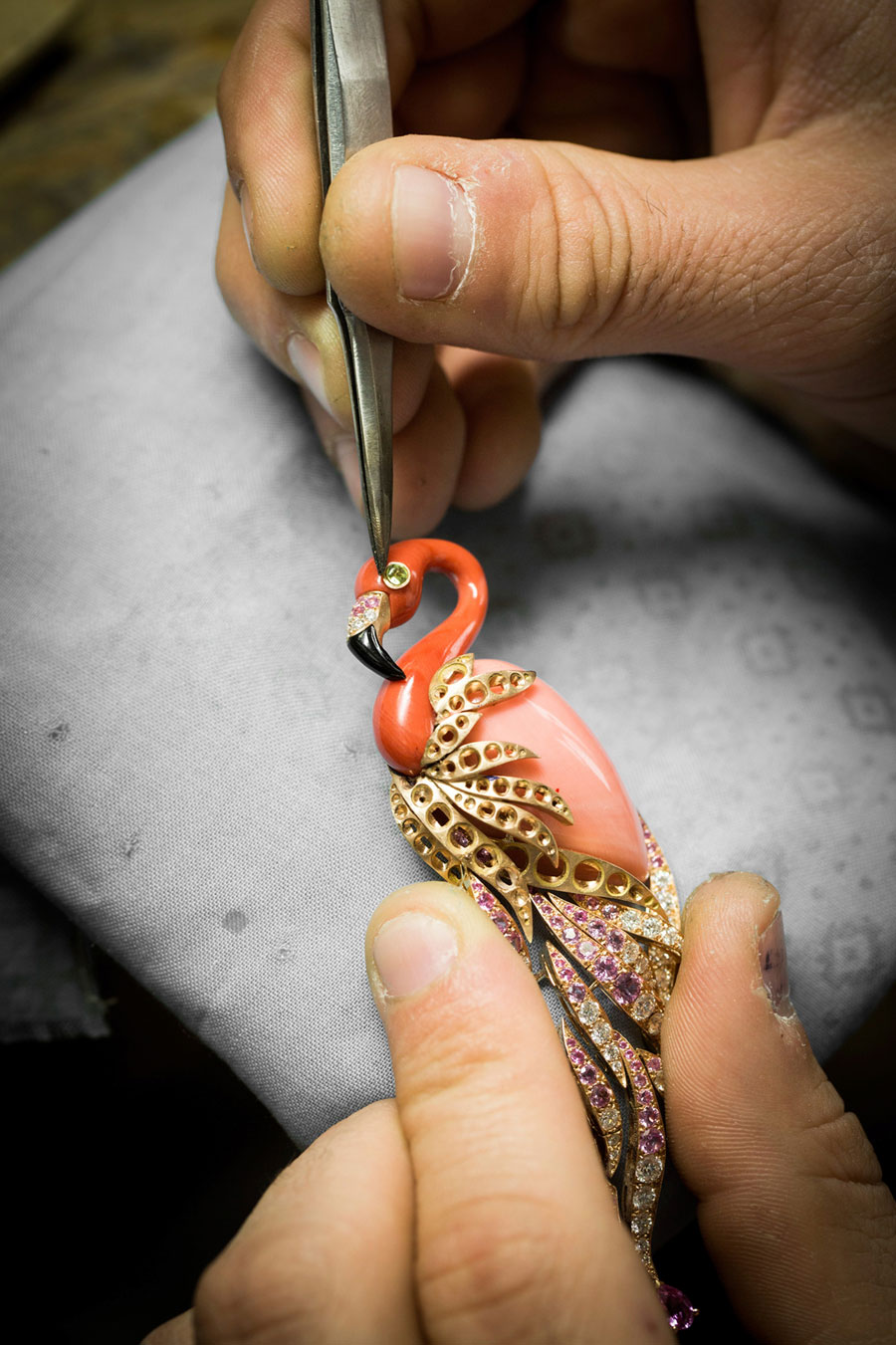
The making of the Flamant Corail necklace with detachable clip in coral, pink sapphires, peridots, onyx and diamonds. Photo © Van Cleef & Arpels.
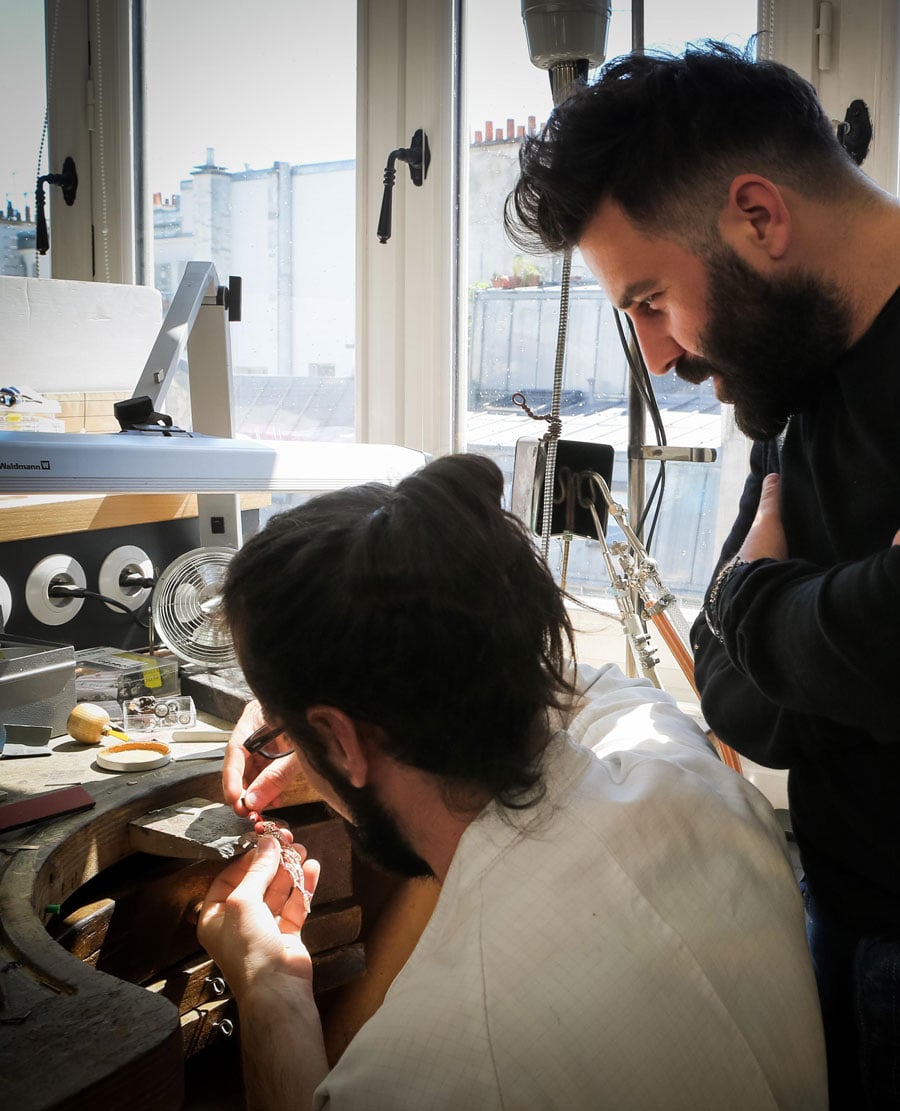
The making of the Flamant Corail necklace with detachable clip in coral, pink sapphires, peridots, onyx and diamonds. Photo © Van Cleef & Arpels.
The design studio
The creative process at the Van Cleef & Arpels’ateliers begins in the design studio. Here, imaginative artists use their inspiration to create a first drawing of what will eventually become a one-of-a-kind Van Cleef & Arpels jewel. After an initial pencil drawing, the design is painted with gouache on grey paper (because on white paper clear and white details like diamonds would be hard to see). For the designer, it is important that every single detail is provided in the drawing, so that the craftsmen will be able to understand his/her intention easily.
The mock-up studio
After the drawing room, the jewel design makes its way to the moke-up workshop, where experienced mock-upmakers create a mock-up of the jewel using pewter and strass crystals (rhinestones). This is an important phase in the design process, because the designer can see his/her drawing come to life without wasting precious materials, and the jewellers can test the weight, movement and shape of a jewel before they start working on the real piece. Van Cleef & Arpels is perhaps the only jewellery house in the world that provides its team with the luxury of a mock-up-making studio, thus enhancing the communication between designers and jewellers and allowing room for testing and creative experimentation.
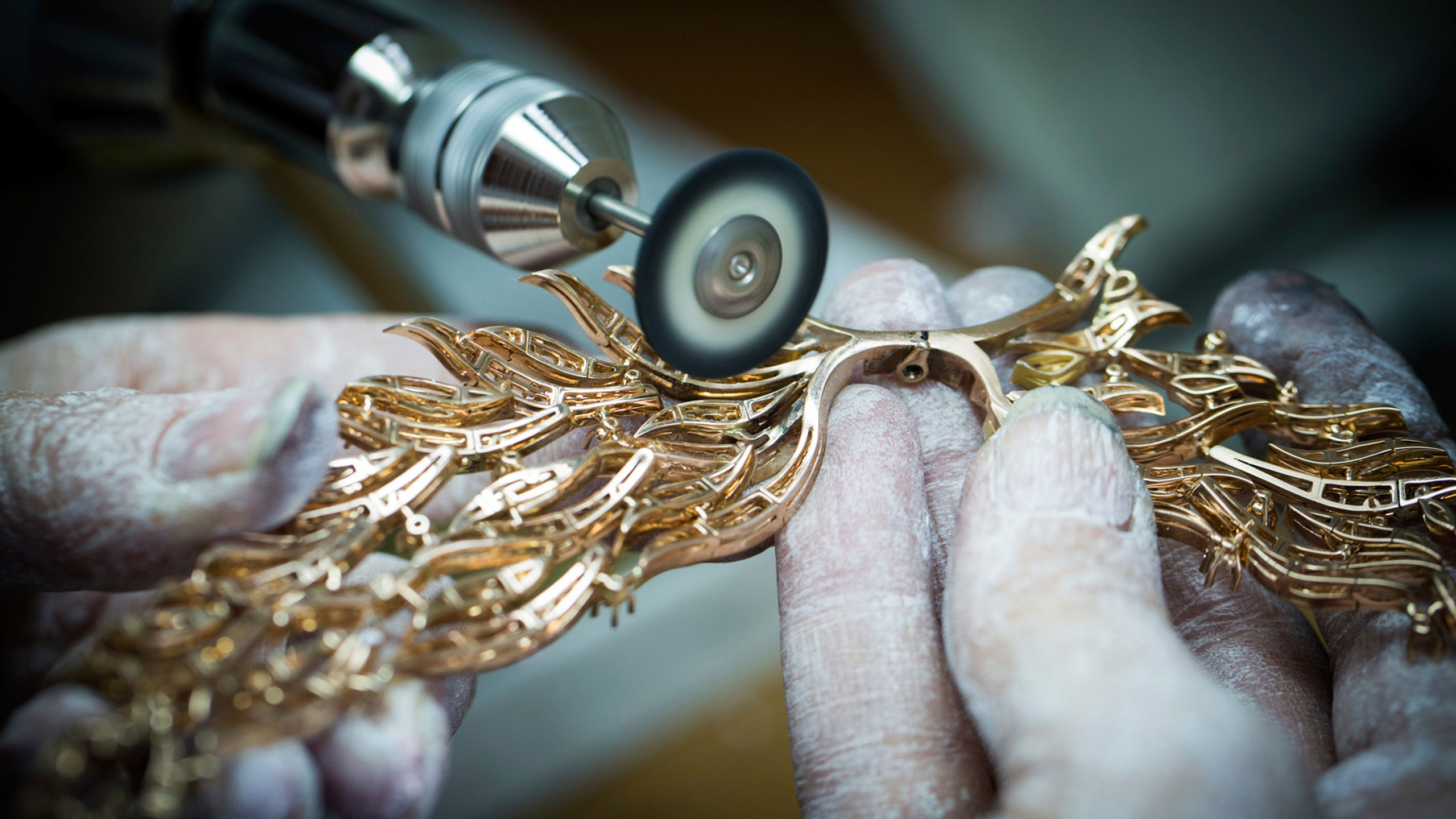
The making of the 'Flamant Corail' necklace with detachable clip in coral, pink sapphires, peridots, onyx and diamonds. Photo © Van Cleef & Arpels.
The jeweller’s workshop
After the mock-up has been made and tested, the design arrives at the jewellers’ workshop, where it will begin to assume its final form. The experienced in house jewellers give shape to precious metals, creating complex structures and mechanisms that give the jewel lightness, movement and strength to hold all its precious stones securely. A great part of the jeweller’s work is to create the piece with as much accuracy as possible, so that all the precious stones will be able to fit perfectly later.
The stone sorters' studio
The stones used for the maison’s high jewellery collections are all of the highest standards of quality and purity, and are all non heated and non treated. All the stones are sourced by a team of expert stone buyers, who constantly scout the market for gems depending on the needs of the ateliers. The designers at Van Cleef & Arpels also use other materials such as coral or turquoise in their designs; these materials are again selected only if they are of outstanding quality. As for diamonds, Van Cleef & Arpels applies perhaps the highest standards of clarity and purity in the market; for the sourcing of all of its diamonds, they follow the Kimberley Process, which ensures that none of the gems are sourced from conflict regions.
Polishing and stone setting
Once the precious metal has been given the shape of the jewel, it is polished by hand until it gleams and all marks made by the jeweller’s tools are not visible (in fact, all the polishing is done only by women workers!) After the metal has been polished, the piece arrives at the gem-setter’s workshop, the ambience of which is different to the rest of the atelier: I actually had to knock on the door and ask for permission to enter because stone-setting demands a lot of concentration. The stone-setters work in silence while securely fixing all the diamonds, emeralds, rubies and other precious gems into the metal frame of the jewel by delicately hammering metal around each stone.
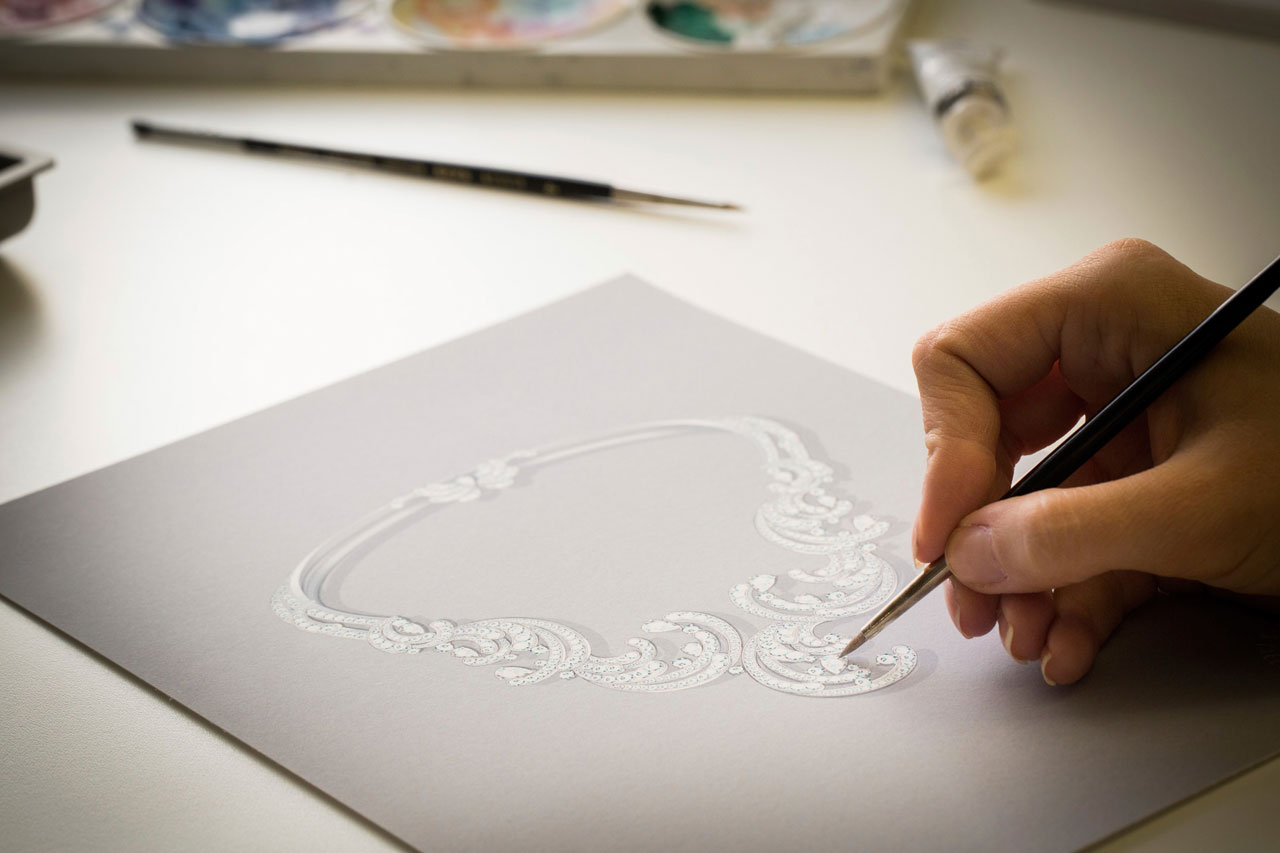
Pangée sketch. Necklace, diamonds. Inspired by the Atlantic and Indian Oceans. Seven Seas high jewelry collection. Photo © Van Cleef & Arpels.
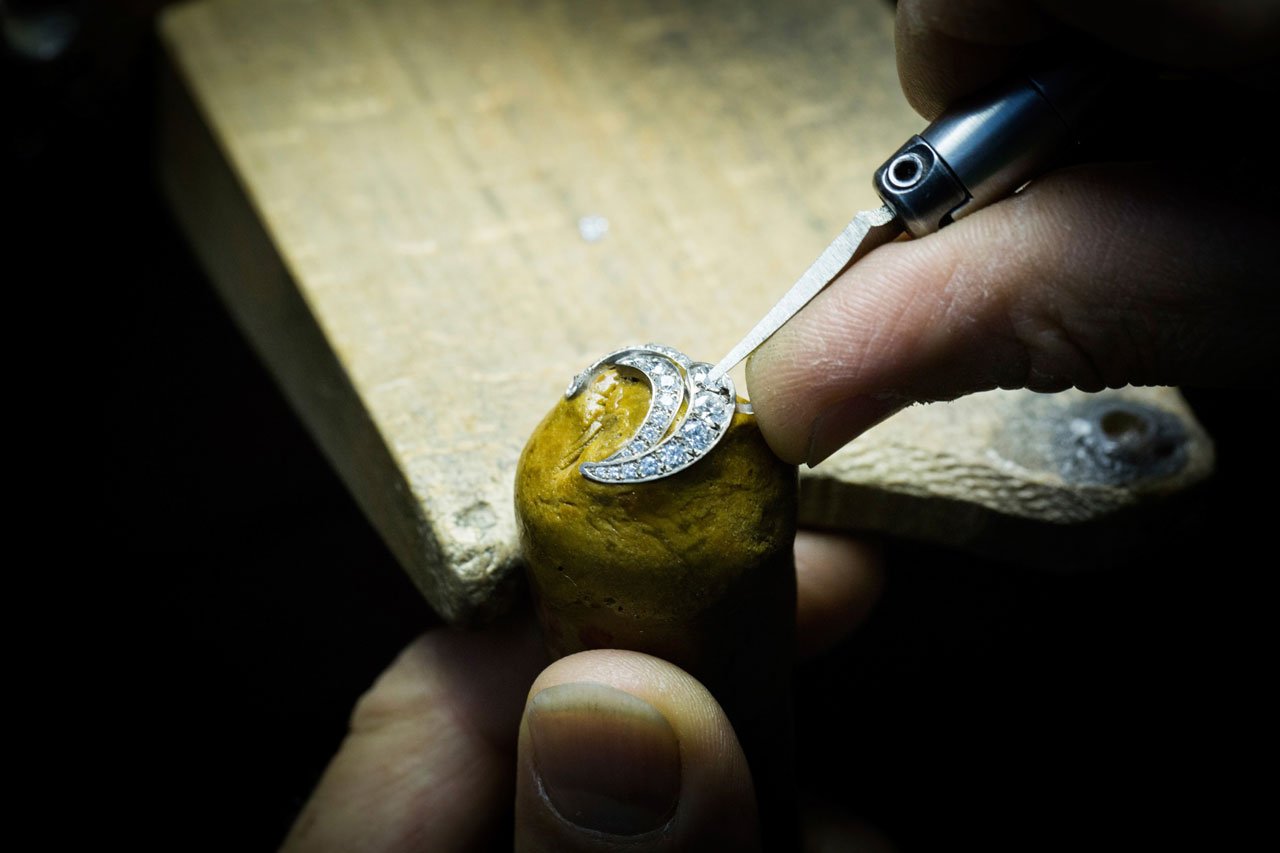
The making of Pangée. Necklace, diamonds. Inspired by the Atlantic and Indian Oceans. Seven Seas high jewelry collection. Photo © Van Cleef & Arpels.
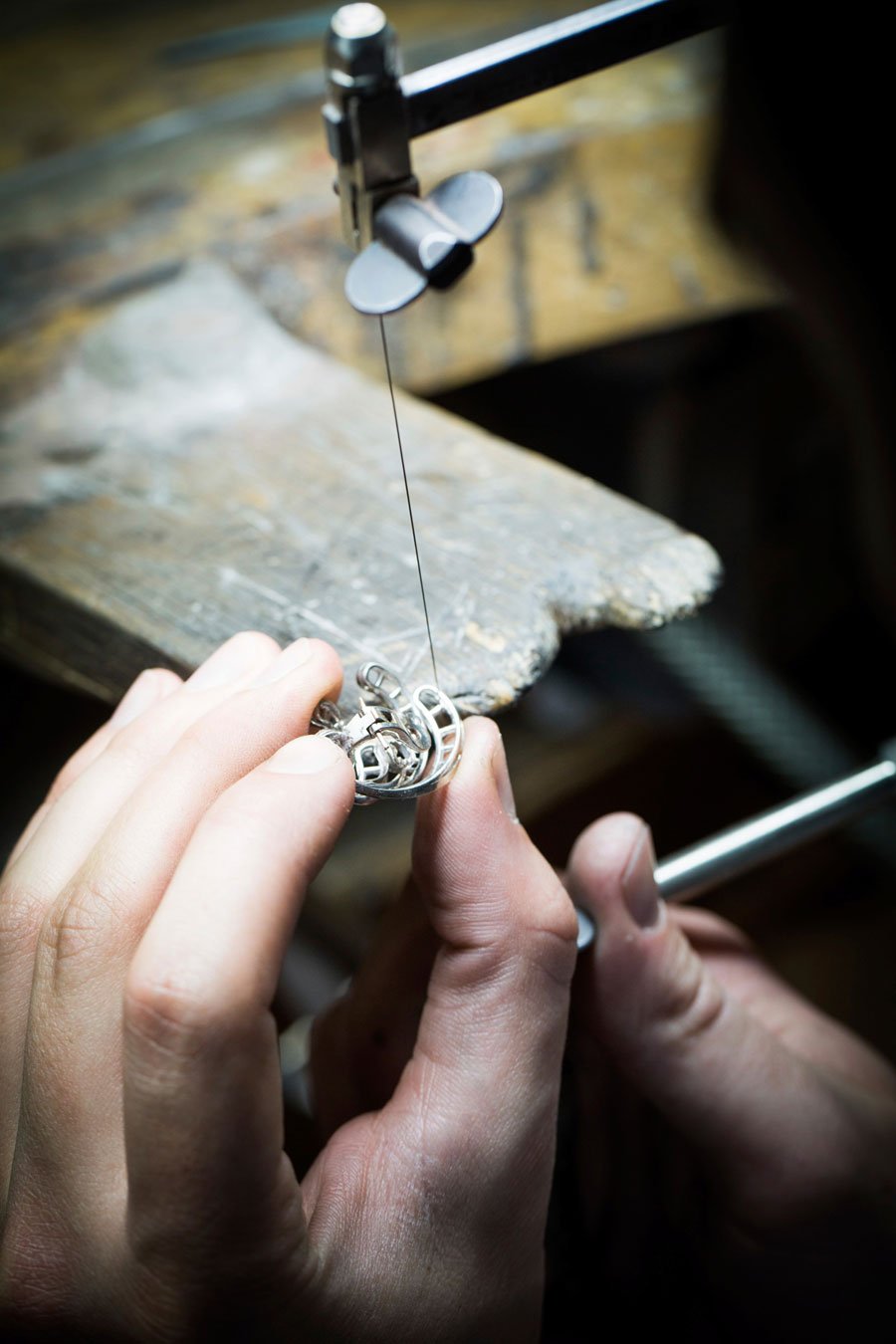
The making of Pangée. Necklace, diamonds. Inspired by the Atlantic and Indian Oceans. Seven Seas high jewelry collection. Photo © Van Cleef & Arpels.
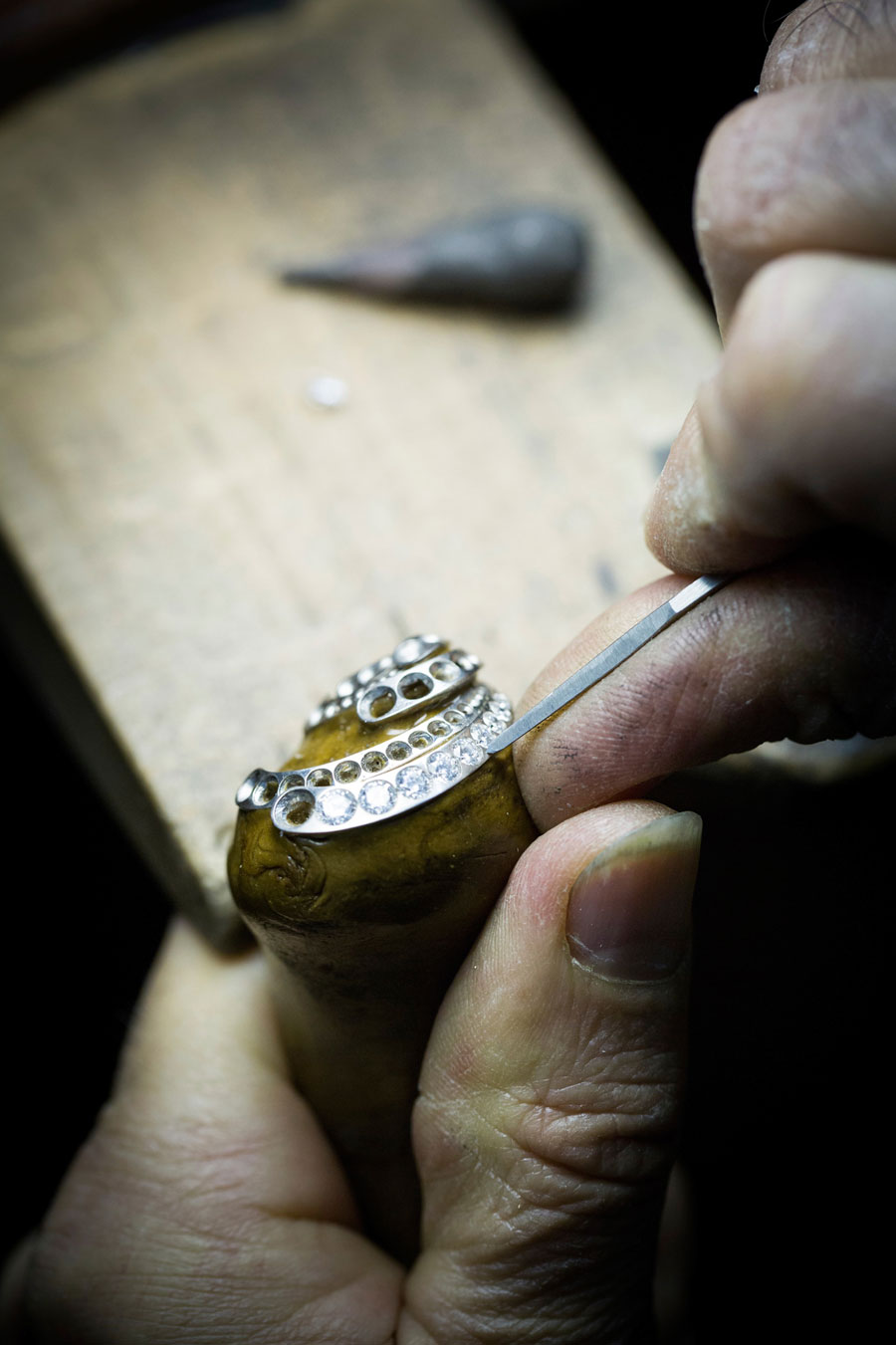
The making of Pangée. Necklace, diamonds. Inspired by the Atlantic and Indian Oceans. Seven Seas high jewelry collection. Photo © Van Cleef & Arpels.
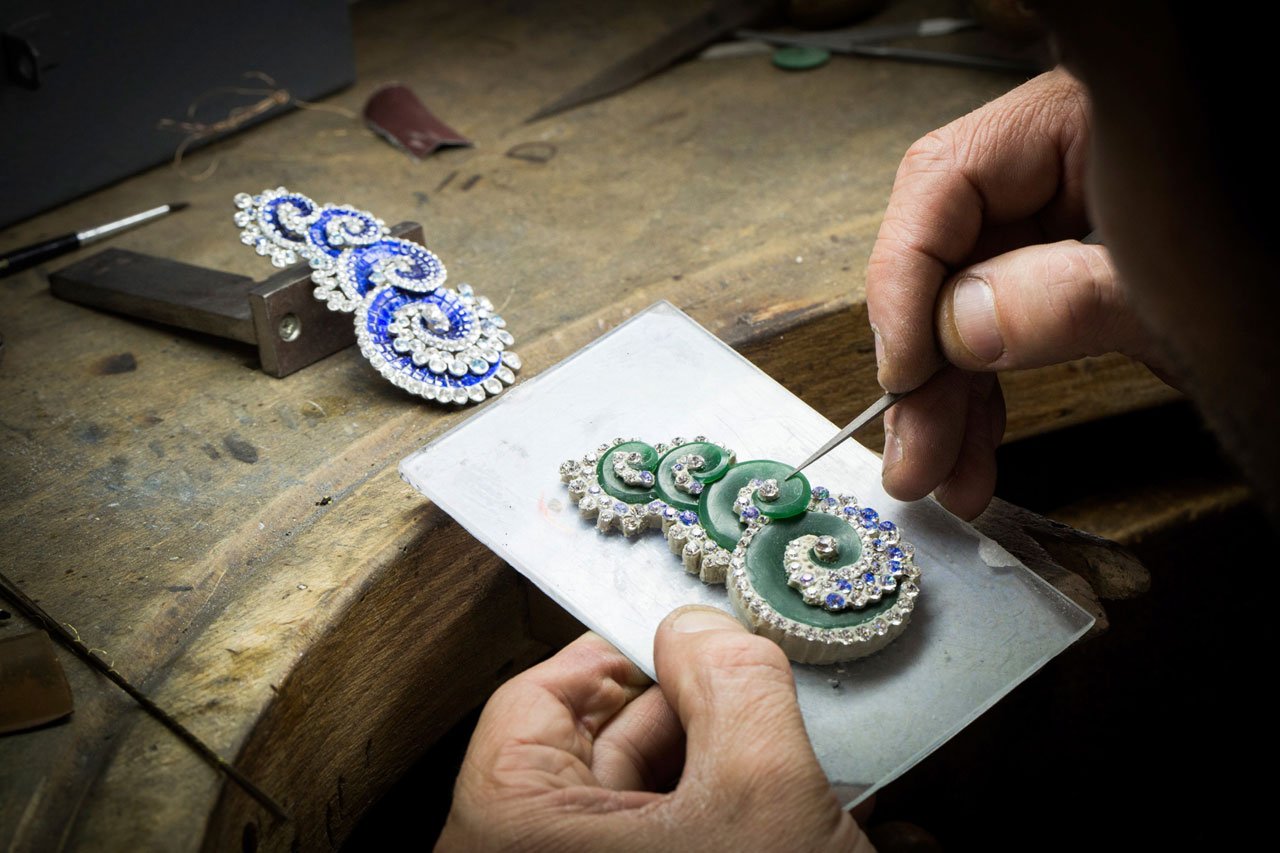
The making of Vagues Mystérieuses. Clip, Mystery Set sapphires, sapphires, Paraíba-like tourmalines, diamonds. Inspired by the Caspian Sea. Sevens Seas high jewelry collection, photo © Van Cleef & Arpels.
A different kind of setting technique is the Mystery Set, which was invented by Van Cleef & Arpels in the 1930‘s and has become one of its signature techniques. The Mystery Set allows for the gems to be set next to one another using small hidden grooves on which the gems are slid onto; each stone requires from two to four hours of work to be set in this way, and only a dozen of people in the entire world have the know how to properly use this technique.
After the gems are set in the jewel, it returns to the polisher’s workshop to be polished one last time and receive its finishing touches and the magical transformation from mere stones and metals sourced from deep inside the earth into a gleaming and awe-inspiring masterpiece materialises!
Seven Seas, Mains d'Or and Mystery Set are trademarks of Van Cleef & Arpels. ©
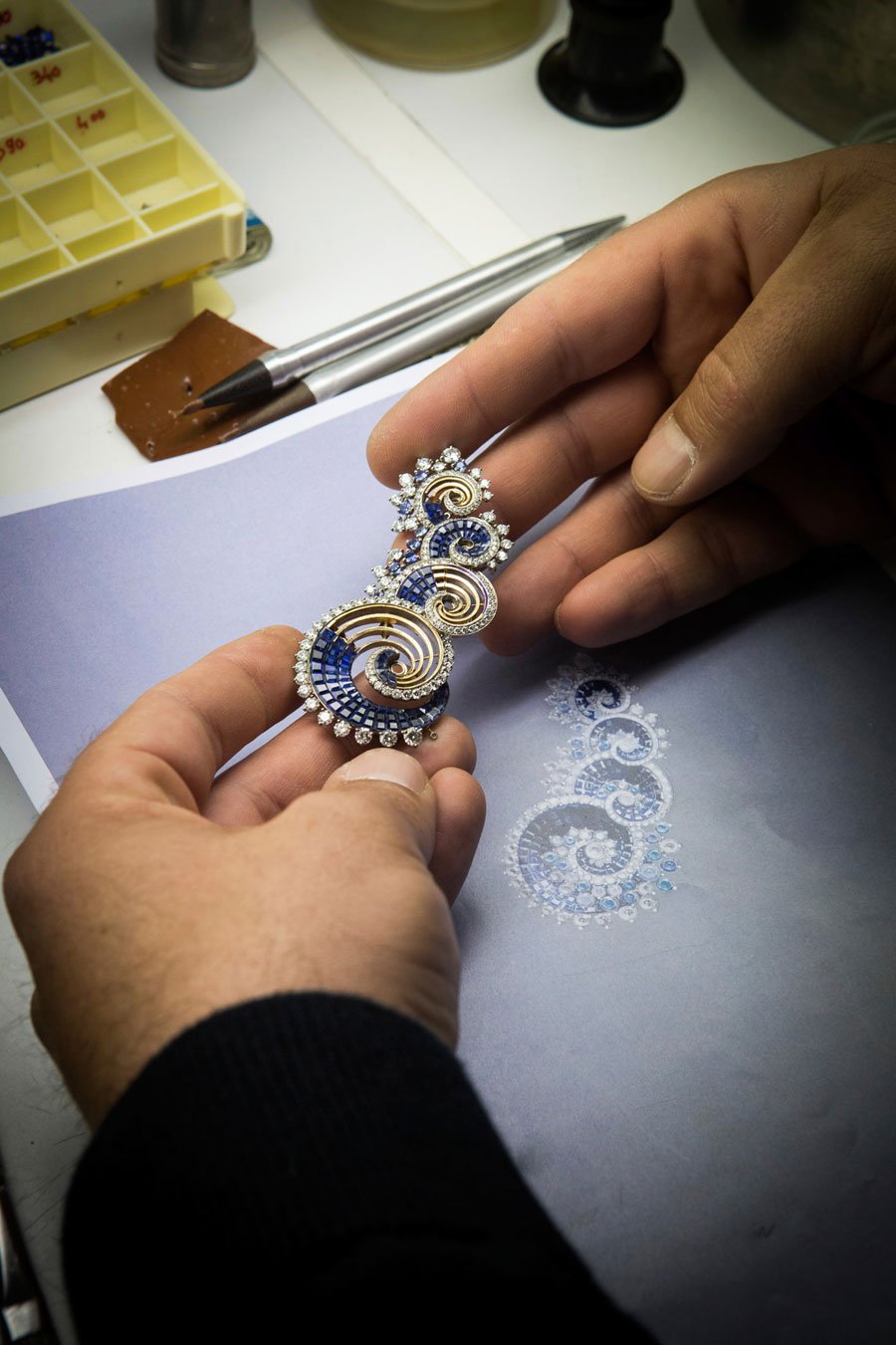
The making of Vagues Mystérieuses. Clip, Mystery Set sapphires, sapphires, Paraíba-like tourmalines, diamonds. Inspired by the Caspian Sea. Sevens Seas high jewelry collection, photo © Van Cleef & Arpels.
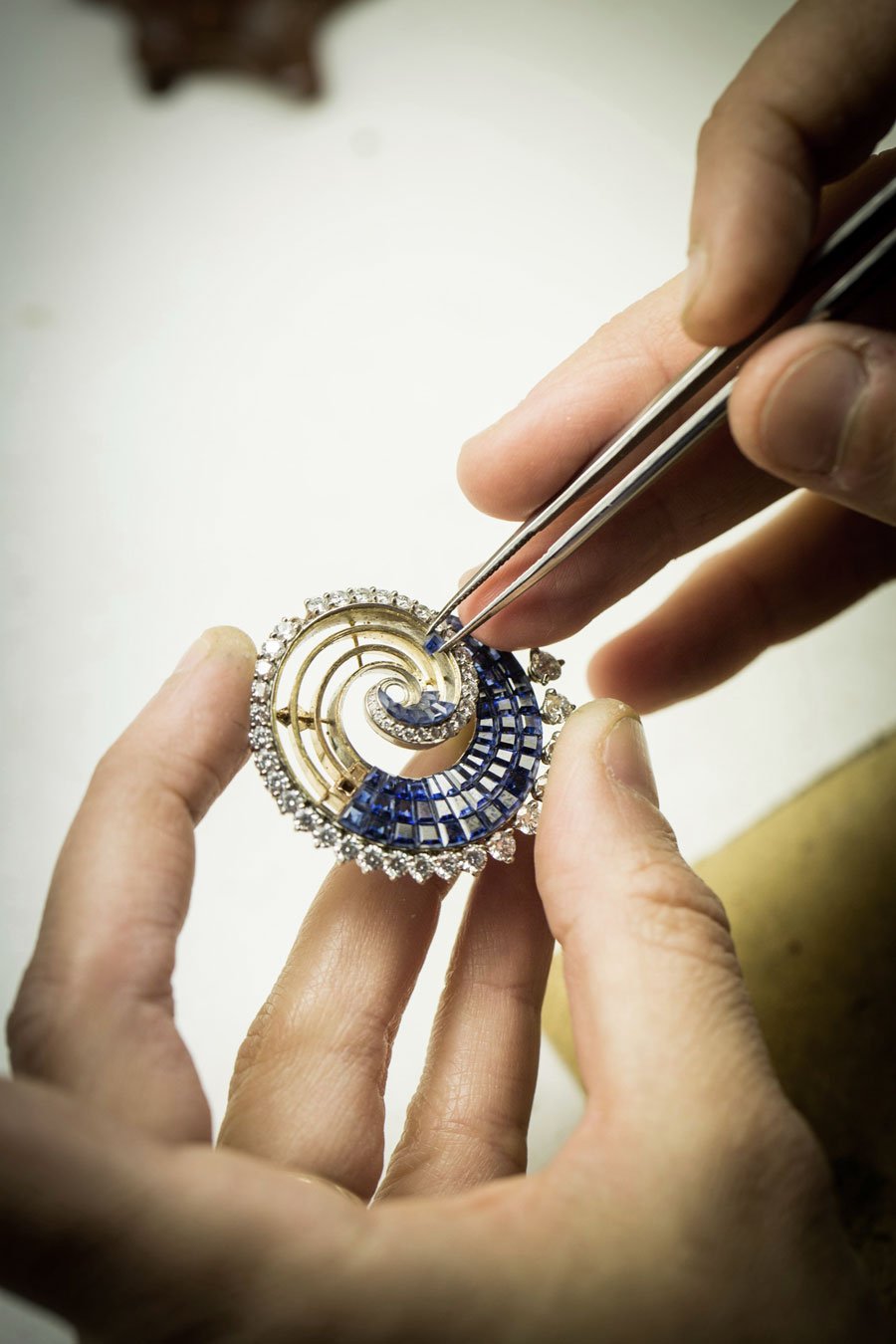
Mystery Set™ work: inserting the sapphire into the structure of the Van Cleef & Arpels Vagues Mystérieuses clip, "Seven Seas" high jewellery collection. Photo © Van Cleef & Arpels.














